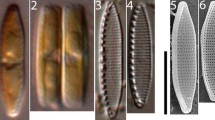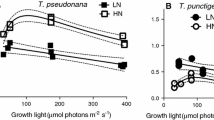Abstract
Four endosymbiotic diatoms were isolated from 2 species of larger foraminifera collected in the Red Sea and Hawaii. The photoadaptive responses of the cultured diatoms were measured at 312, 19 and 7 μW cm-2. Two of the diatoms (Fragilaria shiloi and Nitzschia laevis), both isolated from Amphistegina lessonii, grew fastest at 312 μW cm-2. The other two diatoms (N. valdestriata and N. panduriformis) which were isolated from Heterostegina depressa, grew best at 19 μW cm-2. Of the four diatoms, F. shiloi grew best at high light levels. Also in F. shiloi, chlorophyll c content per cell was directly proportional to light intensity; in contrast chlorophyll a and carotenoids increased to maxima at 19 μW cm-2. The chlorophyll a and c and carotenoid content of N. valdestriata were also maximal at 19 μW cm-2. Photosynthetic rates, measured by respirometry, suggested that the diatoms were photoinhibited at higher light intensities and did well at moderately low light intensities (175μW cm-2). The photocompensation points of all 4 diatoms were about 2% of the light available in the spring at 1-m depth at Elat on the Red Sea. At Elat the photocompensation point would lie between 40 and 50 m if the algae were free in nature. The amount of attenuation of light by the shells of the host has not yet been measured. Presumably photocompensation of the algae within hosts is reached at depths less than 40 m.
Similar content being viewed by others
Literature Cited
Brasier, M. D.: Morphology and habitat of living benthonic foraminiferids from Caribbean carbonate environments. Rev. Esp. Micropal. 7, 567–578 (1975)
Buchardt, B. and H. J. Hansen: Oxygen isotope fractionation and algal symbiosis in benthic foraminifera from the Gulf of Elat, Israel. Bull. Geol. Soc. Den. 26, 185–194 (1977)
Drew, E. A.: The biology and physiology of alga-invertebrate symbioses. II. The density of symbiotic algal cells in a number of hermatypic hard corals and alcyonarains from various depths. J. exp. mar. Biol. Ecol. 9, 21–25 (1972)
Erez, J.: Vital effect on stable-isotope composition in foraminifera and coral skeletons. Nature, Lond. 273, 199–202 (1978)
Hallock, P.: Light dependence in Amphistegina. J. Foram. Res. 11, 40–46 (1981)
Hallock, P. and H. J. Hansen: Depth adaptation in Amphistegina: change in lamellar thickness. Bull. Geol. Soc. Den. 27, 99–104 (1979)
Hansen, H. J. and B. Buchardt: Depth distribution of Amphistegina in the Gulf of Elat, Israel. Utrecht Micropaleont. Bull. 15, 205–224 (1977)
Höttinger L.: Distribution of larger Peneroplidae, Borelis and Nummulitidae in the Gulf of Elat, Red Sea. Utrecht Micropaleont. Bull. 15, 35–110 (1977)
Larsen, A. R.: Studies of recent Amphistegina, taxonomy and some ecology. Isr. J. Earth-Sci 25, 1–26 (1976)
Lee, J. J.: Nutrition and physiology of the foraminifera. In: Biochemistry and physiology of Protozoa, vol. 3, pp 43–66. Ed. by M. Levandowsky and S. H. Hutner. New York: Academic Press 1980
Lee, J. J., M. McEnery and J. Garrison: Experimental studies of larger foraminifera and their symbionts from the Gulf of Elat. J. Foram. Res. 10, 31–47 (1980a)
Lee, J. J., M. McEnery, E. Kahn and F. Schuster: Symbiosis and the evolution of large foraminifera. Micropaleont. 24, 118–140 (1979a)
Lee, J. J., M. E. McEnery, M. J. Lee, J. J. Reidy, J. R. Garrison and R. Röttger: Algal symbionts in larger foraminifera. In: Endocytobiology, vol. 1, pp 113–124. Ed. by W. Schwemmler and H. E. A. Schenk. Berlin: Walter de Gruyter and Co. 1981
Lee, J. J., M. McEnery, R. Röttger and C. Reimer: The isolation, culture and identification of endosymbiotic diatoms from Heterostegina depressa d'Orbigny (larger foraminifera) from Hawaii. Bot. Mar. 23, 297–302 (1980b)
Lee, J. J., M. McEnery, M. Shilo and Z. Reiss: Isolation and cultivation of unusual diatom symbionts from giant Red Sea foraminifera (Protozoa). Nature, Lond, 280, 57–58 (1979b)
McEnery, M. and J. J. Lee: Cytological and fine structural studies of three species of symbiont-bearing foraminifera from the Red Sea. Micropaleont. 27, 71–83 (1981)
Muller-Merz, E. and J. J. Lee: Symbiosis in the larger foraminiferan Sorites marginalis (with notes on Archaias spp.). J. Protozool. 23, 390–396 (1976)
Perry, M. J., M. C. Talbot and R. S. Alberte: Photoadaptation in marine phytoplankton: response of the photosynthetic unit. Mar. Biol. 62, 92–101 (1981)
Prézelin, B. B.: The role of peridinin-chlorophyll a-proteins in the photosynthetic light adaptation of the marine dinoflagellate Glenodinium sp. Planta 130, 225–233 (1976)
Prézelin, B. B. and H. A. Matlick: Time-course of photoadaptation in the photosynthesis-irradiance relationship of a dinoflagellate experiencing photosynthetic periodicity. Mar. Biol. 58, 85–96 (1980)
Röttger, R. Ecological observations of Heterostegina depressa (Foraminifera, Nummulitidae) in the laboratory and in its natural habitat. Mar. Sedimenta Spec. Publ. 1, 75–79 (1976)
Röttger, R., A. Irawn, R. Schmaljohann and L. Franziskat: Growth of the symbiont-bearing foraminifera Amphistegina lessonii d'Orbigny and Heterostegina depressa d'Orbigny (Protozoa). In: Endocytobiology, vol. 1, pp 125–132. Ed. by W. Schwemmler and H. E. A. Schenk. Berlin: Walter de Gruyter and Co. 1981
Saks, N. J. and J. J. Lee: Radiosensitivity and light quality responses of salt marsh epiphytic algae. Proc. Third Nat. Symp. Radioecol., Oak Ridge, Tenn. (1971)
Strickland, J. D. H. and T. R. Parsons: A practical handbook of sea water analysis. Fish. Res. Bd Can. 1968
Williams, D. F., R. Röttger, R. Schmaljohann and L. Keigwin: Oxygen and carbon isotopic fractionation and algal symbiosis in the benthic foraminiferan Heterostegina depressa. Paleogeogr., Paleoclimatol., Paleoecol. 33, 231–251 (1981)
Zmiri, A., D. Kahan, S. Hochstein and Z. Reiss: Phototaxis and thermotaxis in some species of Amphistegina (Foraminifera). J. Protozool. 21, 133–138 (1974)
Author information
Authors and Affiliations
Additional information
Communicated by N. D. Holland, La Jolla
Rights and permissions
About this article
Cite this article
Lee, M.J., Ellis, R. & Lee, J.J. A comparative study of photoadaptation in four diatoms isolated as endosymbionts from larger foraminifera. Mar. Biol. 68, 193–197 (1982). https://doi.org/10.1007/BF00397606
Accepted:
Issue Date:
DOI: https://doi.org/10.1007/BF00397606




